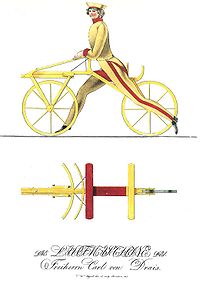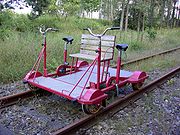
Draisine
Encyclopedia


Rail transport
Rail transport is a means of conveyance of passengers and goods by way of wheeled vehicles running on rail tracks. In contrast to road transport, where vehicles merely run on a prepared surface, rail vehicles are also directionally guided by the tracks they run on...
, driven by service personnel, equipped to transport crew and material necessary for the maintenance of railway infrastructure.
The eponymous term is derived from German
Germany
Germany , officially the Federal Republic of Germany , is a federal parliamentary republic in Europe. The country consists of 16 states while the capital and largest city is Berlin. Germany covers an area of 357,021 km2 and has a largely temperate seasonal climate...
Baron
Freiherr
The German titles Freiherr and Freifrau and Freiin are titles of nobility, used preceding a person's given name or, after 1919, before the surname...
Karl Christian Ludwig Drais von Sauerbronn
Karl Drais
Karl Drais was a German inventor and invented the Laufmaschine , also later called the velocipede, draisine or "draisienne" , also nicknamed the dandy horse. This incorporated the two-wheeler principle that is basic to the bicycle and motorcycle and was the beginning of mechanized personal...
, who invented his Laufmaschine (German
German language
German is a West Germanic language, related to and classified alongside English and Dutch. With an estimated 90 – 98 million native speakers, German is one of the world's major languages and is the most widely-spoken first language in the European Union....
for "running machine") in 1817, that was called Draisine (German) or Draisienne (French) by the press. It is the first reliable claim for a practically used bicycle
Bicycle
A bicycle, also known as a bike, pushbike or cycle, is a human-powered, pedal-driven, single-track vehicle, having two wheels attached to a frame, one behind the other. A person who rides a bicycle is called a cyclist, or bicyclist....
, basically the first commercially successful two-wheeled, steerable, human-propelled machine commonly called a velocipede
Velocipede
Velocipede is an umbrella term for any human-powered land vehicle with one or more wheels. The most common type of velocipede today is the bicycle....
, nicknamed hobby-horse or dandy horse
Dandy horse
The dandy-horse, also known as hobby-horse, is a human-powered vehicle that, being the first means of transport to make use of the two-wheeler principle, is regarded as the forerunner of the bicycle. The dandy horse was invented by Baron Karl Drais in Mannheim, Germany, and patented in January 1818...
.
Later, the name draisine came to be applied only to versions used on rails and was extended to similar vehicles, even when not human-powered. Because of their low weight and small size, they can be put on and taken off the rails at any place, allowing trains to pass.
In the United States, motor-powered draisines are known as speeder
Speeder
A speeder is a maintenance of way motorized vehicle formerly used on railroads around the world by track inspectors and work crews to move quickly to and...
s while human-powered
Human-powered transport
Human-powered transport is the transport of person and/or goods using human muscle power. Like animal-powered transport, human-powered transport has existed since time immemorial in the form of walking, running and swimming...
ones are referred as handcar
Handcar
A handcar is a railroad car powered by its passengers, or by people pushing the car from behind. It is mostly used as a maintenance of way or mining car, but it was also used for passenger service in some cases...
s.
Dressin, velorail or railbike
Draisine is spelled dressin in Sweden and dresin in Norway and dræsine in Denmark. In Finland the word is "resiina". Usually, dressin refers to pedal-powered rail-cycles which were used by railroad maintenance workers in Finland, Sweden and Norway until about 1950, as handcarHandcar
A handcar is a railroad car powered by its passengers, or by people pushing the car from behind. It is mostly used as a maintenance of way or mining car, but it was also used for passenger service in some cases...
s were elsewhere.
Now draisines are used for recreation on several unused railway lines in Germany, Sweden, Norway, Poland and some other European countries. There are several companies renting draisines in Sweden.
In Finland there has been annual competition "Resiina-ralli" (translates "Draisine Rally"), which involves several draisine teams travelling many days on the railways from one corner of the country to another. The rally is televised and is popular with TV-viewers.
Military usage
The military usage of draisines concerned, first of all, armoured draisines. They were light armoured rail motor vehicles, intended for reconnaissance, scouting, track patrolling and other auxiliary combat tasks, usually belonging to armoured trainArmoured train
An armoured train is a train protected with armour. They are usually equipped with railroad cars armed with artillery and machine guns. They were mostly used during the late 19th and early 20th century, when they offered an innovative way to quickly move large amounts of firepower...
s. Early vehicles of this kind were built in Russia during World War I. Later, often armoured cars were used as armoured draisines, after exchanging their wheels to railroad ones, or fitting them with additional retractable railroad rollers. Some countries however manufactured purposely built armoured draisines between the wars, like the USSR and Czechoslovakia. Peculiar vehicles were Polish armoured draisines - they were tank
Tank
A tank is a tracked, armoured fighting vehicle designed for front-line combat which combines operational mobility, tactical offensive, and defensive capabilities...
s or tankette
Tankette
A tankette is a tracked combat vehicle resembling a small tank roughly the size of a car, mainly intended for light infantry support or reconnaissance. Colloquially it may also simply mean a "small tank"....
s fitted with special rail chassis, able to be used on rails or on the ground, leaving the rail chassis on the rails. Some countries developed rail-cum-track armoured draisines, with retractable tracks railroad wheels - they were not widely used, however. Different armoured draisines were used during the Second World War, starting from the invasion of Poland
Invasion of Poland (1939)
The Invasion of Poland, also known as the September Campaign or 1939 Defensive War in Poland and the Poland Campaign in Germany, was an invasion of Poland by Germany, the Soviet Union, and a small Slovak contingent that marked the start of World War II in Europe...
carried out by Nazi Germany
Nazi Germany
Nazi Germany , also known as the Third Reich , but officially called German Reich from 1933 to 1943 and Greater German Reich from 26 June 1943 onward, is the name commonly used to refer to the state of Germany from 1933 to 1945, when it was a totalitarian dictatorship ruled by...
.
Construction
By far the most practical railbikes are those that convert a standard bicycle into a vehicle that can be ridden on tracks. This enables the user to leave home and reach the tracks on his bicycle, convert to railbike mode, and then back again to bicycle mode once he has reached his destination. Obviously, the conversion should be fast and straightforward, involving a minimum of steps and a simple, clamp-on mechanism. Furthermore, operation of the device in railbike mode should be stable and dependable.People have been putting bicycles on railroad tracks ever since there have been bicycles and railroads. From time to time, factory-built models have been available, beginning with a device marketed in 1908 through the Sears catalogue, and which cost just $5.45. At the present time, one can purchase plans to convert a regular bicycle into a railbike.
Railbikes are a great project for do-it-yourselfers. There are a great many designs out there, without any one design laying claim to absolute superiority. (As with cars and airplanes, each design has its advantages and disadvantages.) But regardless of the design, certain fundamentals must be adhered to.
Virtually every design uses a flanged guide roller to keep the bike’s front wheel on the track. In order to do its job this guide roller should support a good portion of the rider’s weight. (Otherwise, the guide roller itself stands a good chance of derailing upon encountering a serious irregularity in the tracks.) In one successful design, the front bike wheel is entirely supported by the guide roller, thus assuring that sufficient weight is pressing down on the roller at all times.
The rear bike wheel, while providing traction through direct contact with the rail, must also be guided so as to prevent derailment. In most designs the rear wheel is guided by an outrigger riding on the second rail. This design is satisfactory as long as the two rails are perfectly parallel. But upon encountering stretches where the tracks are no longer parallel – as frequently happens on abandoned tracks – derailments are all too common. This disadvantage can be overcome by the use of additional guide rollers to keep the rear wheel aligned with the track, but with the penalty of added weight.
As for the outrigger, it is best to have at least three supporting members in order to provide tripod-like rigidity. The roller on the outrigger is best left flangeless, so as to allow for the loss of parallelism between the two rails. From time to time, someone will suggest dispensing with the outrigger altogether. Why not a one-rail railbike? Although not impossible, such a device would carry a steep penalty in stability, and the rider would be reduced to performing a circus act on a tightrope. Keep in mind that bicycles are kept upright by letting the rider steer in the direction of an impending fall, and that this ability is sacrificed when putting a bicycle on rails.

